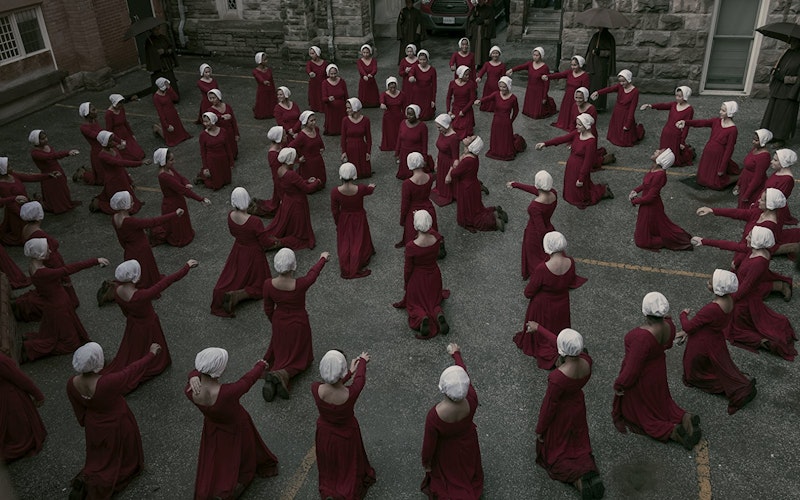
TV
Gestures of Prayer in The Handmaid’s Tale
The world of The Handmaid’s Tale is a dystopia steeped in overt religious imagery and language. Fundamentalists have taken over what was once the United States, renaming it Gilead and setting up an ostensible theocracy. There’s also been a reproductive crisis—most women can’t have babies. The few who can are given the title “handmaid” and forced to live in slavery to Gilead’s leadership, their only purpose to bear children. These women are indoctrinated into the belief system of Gilead through religious ritual, which quotes Scripture but misunderstands its meaning. Religion, then, would seem to be wholly toxic in the show, but in some ways The Handmaid’s Tale can also be viewed as a defense of religious life in general and prayer in particular.
The camerawork keeps the oppressive setting in the front of the viewer’s mind at all times. The mandated farewell in Gilead is “under his eye,” a double-edged sword because it is both a benediction and a reminder that everyone is being watched. The handmaids are under surveillance by the state, but they’re also under God’s watchful eye. In stunning aerial shots, the handmaids in their red dresses and white wimples look like spilled blood on the ground. The camera is observant and exact: rigid lines and squared framing establishes the plight of the characters. Flashbacks feature looser camerawork, allowing for more diagonal approaches to the characters in the frame, capturing a less repressed time and setting. Throughout, handheld, extreme close-ups allow the viewer to understand exactly what June (Elisabeth Moss), the titular handmaid, is thinking and feeling.
Although she’s mostly outwardly silent, afraid to speak, we can see June’s emotions crawl across her face and we can hear her inner dialogue in voiceover. In season one, much of this dialogue was narrative, explaining her reactions in real time, revealing that although outwardly she’s going along with the system, inwardly all she wants to do is to find her husband and daughter. In season two, now that viewers have acclimated to the world of the show, June’s inner monologue has taken on a new flavor: that of prayer.
At first, June’s prayers sound sardonic. The first time we hear from her in the current, second season, she’s reacting to a mock execution put on by the leadership of Gilead. Surrounded by her frightened fellow handmaids, all June can pray is this: “Our Father, who art in Heaven, what the actual f***.” Her choice of words is strong, but it’s heartfelt and honest, a cry for help. The rest of her inner monologue when she’s surrounded by her oppressors comes across the same way. She’s praying daily, asking for help, for relief, for the chance to escape.
In season two, June’s inner monologue has taken on a new flavor: that of prayer.
June’s inner prayers contrast sharply with the outward trappings of religion in Gilead. The men who lead the country dress like clergy. The older women who train the handmaids—known as “aunts”—are dressed like friars, or nuns, or even plague doctors depending on the setting. Everything the aunts say is laced with quotations from the Bible, but they’re all admonitions, warnings, threats. Scripture in the mouths of these women is difficult to hear, because although the quotes are accurate, they’re used to beat down the already downtrodden and to justify the torture of noncompliant handmaids. Everything the handmaids do adheres to a kind of twisted liturgy, including the ritual assemblies led by the aunts and the greetings they give each other. Although the country gives off an overly religious appearance, it’s morally and spiritually dead. Religion in Gilead is a weapon against the oppressed, not an encouragement, and certainly not a model of love and mercy.
Gilead displays a fundamental misunderstanding of the truth of the gospel. Jesus came to fulfill the law, not to create more rules. Christ came to set the poor and the prisoner free, not to enslave them further. In The Handmaid’s Tale, the compassionate eye of the camera and June’s own interior life offer flickers of liberation theology. Gustavo Gutiérrez defines God’s people as those who do justice by caring for the oppressed, particularly the poor, through “concrete actions.” This separates external worship from worship that comes from the heart and reflects God’s will. Worship and prayer in this model are meant to be lived out in daily life, not oppressive ritual.
In spite of her physical, mental, and spiritual abuse, June holds on to her faith. Even when she’s under extreme distress, she continues to practice what Gutiérrez describes as silent prayer. The second episode of season two closes with just such a moment. In an office building that was used as an execution chamber for those who once worked there, June takes the opportunity to pray for the souls of the departed. This time, she is not following the prescribed prayers of the aunts; she’s praying of her own volition, in an effort to bring peace to the room. As she covers the bullet holes in the wall with mementos of the people who were killed there, she covers death with reminders of life. The moment reminds us that prayer is both dialogue and action, a chance to live out God’s commands in both internal contemplation and daily action.
Topics: TV